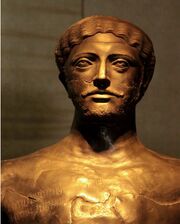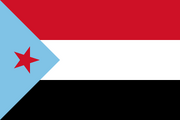| |||||||
| Anthem | United English | ||||||
| Capital (and largest city) | Sana'a | ||||||
| Language - Official: |
Arabic | ||||||
| - Other languages | English | ||||||
| Religion | Islam (government is officially secular) | ||||||
| Type of government | Unitary semi-presidential constitutional republic | ||||||
| President: | Osama al-Hejad | ||||||
| Prime Minister: | Yasmin Mahmoud al-Fouad | ||||||
| Area | 633,591 | ||||||
| - Water (%) | Negligible | ||||||
| Population | 34,288,363 | ||||||
| - 2013 estimate | 35,021,333 | ||||||
| - 2011 census | 33,441,332 | ||||||
| Independence | from United Kingdom | ||||||
| Declared | 2nd September 1943 | ||||||
| Recognized | 4th February 1944 | ||||||
| Currency | Yemeni Rial | ||||||
| GDP (nominal) | £857 Billion | ||||||
| - Total | £857 Billion | ||||||
| - Per capita | £24,994 | ||||||
| HDI | 0.792
high | ||||||
| Drives on the | Left | ||||||
| Date formats | dd/m/yyyy | ||||||
| Internet TLD | .ye | ||||||
| Calling code | +967 | ||||||
The Yemeni Republic (Arabic: الجمهورية اليمنية; al-Jumhuriyyah al-Yamaniyyah) or Yemen is an Arab nation located in the Middle East, occupying the southwest area of the Arab Peninsula. It is bordered by North Desert to the north and east, Oman to the southeast, the Red Sea to the west and the Aden Sea to the south.
Yemen is one of the oldest centres of civilization in the Near East. Its capital and largest city is Sana'a. Yemen's territory includes more than 200 islands, the largest of which is Socotra, about 354 km (220 mi) to the south of mainland Yemen. It is the only state in the Arabian Peninsula to have a purely republican form of government. Yemen was the first country in the Arabian peninsula to grant women the right to vote.
Yemen is a modernized country, with a political system heavily based off the US model. Ever since oil was struck in 1948 in the western provinces (unlike in OTL where the oil was focused on the east provinces), the country has had a vast boom in its economy. Despite this Yemen is still suffering from the consequences of the Middle War, and also reports of corruption and nepotism are rife within the political system.
Yemen is a member of the Asian Union, the United Nations and the British Commonwealth, with the second largest amount of medals behind the United Kingdom in the Commonwealth Games.
Etymology[]
One etymology derives Yemen from yamin, meaning "on the right side", as the south is on the right when facing the sunrise. Another derives Yemen from yumn, meaning "felicity", as the region is fertile. The Romans called it Arabia Felix (Happy Arabia) as opposed to Arabia Deserta (Deserted Arabia), which was their term for northern Arabia. Yemen was mentioned in Old South Arabian script as Yamnat particularly after the unification of the four dynasties of ancient Yemen by the Himyarite kings and it literally means "the south-land".
History[]
Ancient Kingdoms[]

Dhamar Ali Yahbur II, King of Sheba, Dhu Raydan, Hadramout and Yamnat (Himyrite Kingdom)
Yemen has long existed at the crossroads of cultures. It linked some of the oldest centres of civilization in the Near East by virtue of its location in the Arabian peninsula.
Between the 12th Century BCE and the 6th Century CE, the Minaean Sabaean (biblical Sheba), Hadhramaut, Qataban and Himyarite Kingdoms controlled the lucrative incense and spice trade in the region.
In the 8th century BCE, the Sabaens built the four-meter tall and 580-meter long Marib Dam. Led by the priest-king Karib'il Watar I, the Sabaeans unified most of Southern Arabia in the 7th century BCE and established a confederacy with the Hadramites and Qatabanis. Lack of water in the Arabian peninsula prevented the Sabaeans from unifying the entire peninsula; instead, they established various colonies to control trade routes. Similar colonies were found in northern Ethiopia, as well, and descriptions of Sabaean presence in the extended border of Palestine are also found in the Hebrew Bible, including an attack on Job. Ancient Yemenis developed a writing system by the 10th century BCE called Musnad, which used to be the main writing form for the entire Arabian peninsula until the 6th century CE.

Ancient Sabaean inscription in 8th century BCE

The Arab peninsula in 1914
Around the 1st century BCE, leaders of the Banu Hamdan confederation (Hashid and Bakil) overthrew the Sabaean royal family and subjugated them to slavery. The Hamdanis formed an alliance with Hadramout and burned the Qatabani capital of Timna. The Himyarites, as a Qatabani sub-tribe, ignited a long but sporadic civil war to avenge their "cousins", as a mid-1st-century BCE Hamdani inscription read. The civil war was over with a decisive Himyarite victory around 275 CE. They established a centralized rule with Zafar as the capital instead of Marib. The Himyarites secured the trade routes through the Kingdom of Kindah who launched several successful campaigns against the Lakhmids in Southern Iraq.
In the 6th century, sectarian violence between Jews and Christians weakened the central government. Jews and pagans, led by Joseph Dhu Nuwas, inflicted heavy casualties on Christian tribes, particularly in Najran. Dhu Nuwas was deposed around 525 – 527 CE after Byzantine Emperor Justinian I sent a fleet to aid the Christians of the Yemen. The Southwestern coasts of the Arabian peninsula became a Byzantine puppet state until the occupiers were driven out by Himyarite Jewish elites.
Islam, the Ottomans and the British
In the 7th century, the Yemeni tribes accepted Islam and played a major role in the Muslim conquest of the Middle East, North Africa and Spain. In the late 12th century, the Ayyubid dynasty, based in Egypt, took control of both Yemen and neighbouring areas. Following the Ayyubid conquest, Yemen was held by the dynasty until a deputy governor proclaimed his independence from them in 1229. In 1538, the Ottoman Empire absorbed Aden and Yemen, and between 1547 and 1548 Sana'a and Tihama were reconquered from the Portuguese, until the Ottomans were expelled in 1630. In 1839, Aden came under British rule. When the Suez Canal opened in 1869, Aden served as a major refuelling port. The Ottoman Turks tried to regain control of Yemen in 1849 but failed. The Ottomans returned in 1872 and took over the northern half of the country. However, the Ottomans were constantly harassed by the Zaydi tribes led by Imam Yahya, until a consensus was reached. Upon the Italian assault on Yemen from Eritrea, Imam Yahya recognised the political authority of the Ottomans in return for his recognition as the religious Imam of Yemen in 1911.[31]
Imam Yahya stayed loyal to the Ottomans during World War I and did not join the Arab revolt that started in 1916 through British instigation. As a result of the defeat of the Ottoman Empire in World War I and the signing of the Armistice of Mudros, the Ottomans surrendered their remaining garrisons and retreated from Yemen in November 1918. Imam Yahya entered Sana'a on 17 November 1918 and declared his independence.
The Yemeni Arab Republic[]

The flag of the Yemeni Arab Republic under Imam Yahya.
Imam Yahya declared the state as the Yemeni Arab Republic, with him as supreme leader. Initially the country was lauded for its reform plans by both the west and the east. However it soon proved that Yahya was a tyrant, and he was overthrown in a velvet revolution in 1921. A provisional government was set up and the country's first elections were held in 1923. The government fully emancipated women, became secular and slowly introduced a welfare state.
The republic is known for funding Mao Zedong, the Chinese revolutionary, despite pleas from the public. They also held relations with Britain, the US, the USSR and Ethiopia.
The Sandstorm War[]

Adolf Hitler with the Foreign Minister of the Worker's State Yusuf al-Abdul Aziz
In 1937, Ibn Saud was installed by Nazi Germany, creating the Worker's State of Arabia. He soon declared war on Yemen to expand his borders. Initially, Ibn Saud's advance was rapid, with support from the Wehrmacht on the battlefield and the Waffen-SS internally, to maintain order. Yemen pleaded with its former ruler, Turkey, for help. However Turkey was just recovering from its own revolution, so had little money or time to spare. Britain however promised to help as long as Yemen would re-assimilate into the British Empire. This controversial pact was signed on 2nd April 1937, when the Saudis were at the gates of Aden. The British funding the Yemenis managed to combat the Wehrmacht, leading to one of the bloodiest battles in history in the Battle of the Sarawat Steppes, which after weeks of intense hand-to-hand fighting and sniper duels, led to a Yemeni victory. A peace treaty was signed and Yemen was re-assimilated into the British Empire. Yemeni troops were instrumental in the victories in North Africa and Indochina during WWII with Yemen being a national hero and ally to the Vietnamese, and Yemeni airmen were involved in destroying the Japanese Carrier Shinano during the battle of Hainan.
The Third Republic[]

Flag of the Third Republic of Yemen.
During the war, independence fever swelled, and the people protested for an independent Yemen once more. The British agreed to grant the nation independence if the Yemeni Army would invade and destroy Ibn Saud's kingdom. However no party won the majority vote in the first elections and a small civil war ensued, famously ending with the Battle of Sana'a. Farid al-Basindawa, who fought in the battle was declared acting leader while the country sorted itself out. The main rivals of the civil war, the Communist party and the Yemeni Muslim Brotherhood were exiled to the Worker's State. Once WWII had ended the British and the American's sent aid money toward the country, which was suffering from a cholera outbreak.
The Middle War[]

Yemen Socialist Party flag, and the flag of the successor state: The People's Democratic Worker's Islamic Federal State of Wahhabi
As promised, Yemen declared war on Ibn Saud in the waning months after the war. This time around, without Nazi funding or support, the regime fell quickly and Yemen conquered the OTL area of Saudi Arabia. However the Communists and the Muslim Brotherhood had formed an unusual alliance against Yemen, and soon the famous Middle War (named for its concentration around the middle of Arabia and also its time period) started. In the short time Georgy Malenkov of the USSR was in office, he diverted a huge amount of funding and support toward the communists, most notably a nuclear bomb and chemical gas weapons. The Yemeni army fought bitterly for 6 years, losing Riyadh to a nuclear weapon and losing the north

Photograph taken from Central Air Force Base, 200 miles from Riyadh when the Communists launched the nuclear bomb. Notice the already devastated infrastructure and cratered suburbs.
and eastern provinces. However the discovery of oil in 1948 provided funding for the Yemeni army. Soon the Muslim brotherhood was wiped out, and the communists weakened enough to force their surrender. The west and north of OTL Saudi was marked as Yemeni, and the East property of the Communists. However the north territory ceded off from both nations to form the Islamic Emirate of Arabia in 1957. The eastern nation is known as the People's Democratic Worker's Islamic Federal State of Wahhabi, and is known collectively with the Islamic Emirate as 'North Desert' due to many not recognizing the legitimacy of either government.
Politics[]
Yemen's political history has been fractured ever since its independence from the Ottoman Empire. Under Imam Yahya it was a totalitarian Islamic state based around Sharia law. One was to revere unto God, Leader and Country. The Yemeni Arab Republic was based around western ideals of democracy and liberalism, declaring the Yemeni Charter on the Rights of Man in 1928, which still governs Yemen today. It abolishes slavery, racial and gender discrimination, gives voting rights to all over 15, allows free speech, free religion and the right to bear arms. The Yemeni Arab Republic was dominated by the Labour Party, who could be described as socialists. Other parties included the Islamic Party and the Democratic Party. Yemen was one of the few countries to denounce the newly formed Nazi Germany in 1933.
During the Sandstorm War, the Labour Party enacted conscription and moved all non-military people into Arms Manufacturing. Whilst this almost certainly saved Aden from capture, it was a highly unpopular move, and they were further ostracized for their choice to plea bargin with Chamberline and the British. After WWII had ended and the acting government held elections, the choices were split relatively equally between the Islamic Party, the Democrats, the new Communist party and a new, smaller party called the Felix party. The Islamists, after a brief power struggle between the moderates and radicals, was reorganized into the Yemeni Muslim Brotherhood. The party led a military coup and took power, starting the four-month long Yemeni Civil War. While this was going on Yemen was fighting the early stages of the Middle War, meaning the military was stretched too thinly to do anything. Eventually Farid al-Basindawa of the Felix during the Battle of Sana'a pushed to the houses of parliament, alone. He marched in and killed the main members of the Muslim Brotherhood. He was declared acting President, to help rebuild Yemen with the Democrats and Communists. However it was found out the Communists had used chemical weapons on soldiers, so they were therefore expelled from the country with the Muslim Brotherhood. Ibn Saud promised them asylum as long as they agreed to quell the Yemeni advance. However, Basindawa proved to be an excellent military leader, and it was too late for Saud. In the next 5 years until 1952, Basindawa managed to maintain a country despite a bitter, costly war, rampant poverty and lack of supplies.
After the Middle War was finally over, Basindawa focused on increasing oil exports. He made an agreement with Russia that Yemen would control Southern Hemisphere oil trade, and Russia would cover the north. He improved the Yemeni Charter as well, striking homosexuality off the mental illness list in 1949 and legalizing it in 1954. He also ended the mandatory law that men and women have to adhere to the hijab, and even made it illegal for women to wear the Niqab or the Burka while driving. He joined the Commonwealth in 1960.
Basindawa and the Feles, after winning the first elections of the Third Republic in 1953, decided to follow the French system of government, with a President holding direct power and the Prime Minister assisting and acting for the President in cases. He also added a US style senate to the mix, called the 'Yemeni Council.' This is the Yemeni government's current form. Generally the two major parties are the Feles and the Democrats, with the Social Democrats (reformed Labour) getting a few votes as well.
Foreign Relations[]
Yemen's foreign relations can be described as uniform. They hold good relations with other Arab nations apart from North Desert, being one of the first Arab nations to recognize Israel as a state. Yemen holds warm relations with its former colonizers Turkey and the UK, being a member of the British Commonwealth and the Ottoman Alliance. It has great relations with Russia, especially after the Russo-Yemeni Oil Agreement of 1951. Yemen has been one of the drivers into developing countries for aid, especially with ally and former colony Ethiopia, and Vietnam. Vietnamese troops were notable for helping fight the Middle War, repaying the debt the Yemeni Army did by liberating them from Japan.
Yemen has often been described as 'Friend of the Free World,' due to its general friendliness toward foreign nations.
Military[]

The Yemeni Army firing mortars on an Al-Qaeda position in Bahrain.
The Yemeni Armed Forces are the largest in the region, with roughly 600,000 active personnel. The majority of weapons are British or Lao, with a few Yemeni made HMGs and turrets. Generally considered an ordered, respectable force, the YAF have been the main player in the war on terror, acting out several operations in North Desert, Bahrain and Syria. The army makes up 400,000 troops, with the navy and air force taking 100,000.

Yemeni High Generals preparing for the Battle of the Sarawat Steppes
Yemeni marksmen are widely considered the best in the region, with one man, Omar Malik, taking down as many as 1,523 troops during the early stages of the Battle for Riyadh during the Middle War, and sniper kills in the Battle of the Sarawat Steppes during the Sandstorm War were roughly 350,000, over one third of the total casualties.


